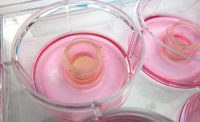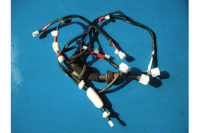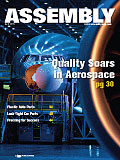
There are remarkable similarities between an oasis, an island of green in a sea of barren sand, and the OASIS, the Online Aerospace Supplier Information System.
Just as a desert oasis provides sun-seared travelers with access to life-sustaining water, OASIS gives as-semblers access to the biggest OEMs in aerospace, names like Boeing, Airbus and Lockheed. One reaches a desert oasis only through a grueling journey that often yields wisdom and self-discovery. Simi-larly, assemblers can gain entry into OASIS only by complying with the procedures set forth in the AS9100 quality standard, a process that often yields wisdom and self-discovery.
“[Assemblers] can make money on AS9100, if they put it in place properly,” says Chris Paris, vice president of operations at Oxebridge Quality Resources Inc. (Winter Haven, FL), a consulting firm spe-cializing in helping manufacturers meet ISO and related standards, including AS9100. “OASIS is an elite club. The only folks who have access to that data base are the purchasing managers of aerospace primes.”
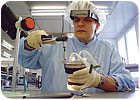
Certified to the European equivalent of AS9100, Jena-Optronik (Jena, Germany) makes optoelectronic instruments and sensors. Here, integration and test engineer Wolfgang Egerer assembles the optical head of a satellite component. Photo courtesy The Boeing Co.
ISO and Then Some
AS9100 was developed in 1999 by the International Aerospace Quality Group, a coalition of aerospace organizations and manufacturers in North and South America, Europe and Asia. Published in the Ameri-cas by the Society of Automotive Engineers (SAE, Warrendale, PA), AS9100 is now its third revision, which was released in January.AS9100 is based on the ISO 9001 quality management standards, but includes additional requirements specific to aerospace manufacturing. For example, one such requirement concerns configuration manage-ment. Engineering change orders are a way of life in aerospace assembly, and manufacturers must have ways of ensuring that the correct part or subassembly is being used at every stage of production. Manufac-turers must make certain the shop floor is using the most current part documents and drawings, and every part must be identified so its exact version can be readily determined.
A similar provision covers identification of parts for traceability purposes. “In the event that an aircraft falls out of the sky, the FAA must be able to trace every part or material back to its manufacturer,” says Paris.
AS9100 also outlines requirements for ensuring the design process is robust and well-documented. “If manufacturers don’t have a fairly formal design program, they may be shocked by the requirements for design plans, verification and validation,” says Paris.
To comply with AS9100, assemblers need to practice stricter oversight of their suppliers. Assemblers must maintain records showing what each supplier is approved to provide. Other provisions cover the terms and conditions for purchase orders.
“One issue that often comes up is that customer requirements are not picked up and [communicated] during the contract review process,” says Paul Dionne, global aerospace program manager at Intertek Testing Services NA Inc. (Boxborough, MA), a certifying body for AS9100 and other ISO standards. “Let’s say Boeing issues a purchase order to a contractor, but it wants to do a first article inspection of the product at the contractor’s facility before the order ships. If the contractor...overlooks that require-ment, Boeing doesn’t have to accept those parts.”
The standard’s requirements for preventing foreign object damage (FOD) often surprise assemblers, says Paris. The purpose of FOD control is to prevent stray objects such as dirt, packaging materials or misplaced tools from causing an accident. Depending on the nature of the assembly, this can be a major undertaking. “If you’re manually assembling small parts, FOD control is not that big a deal,” he ex-plains. “If you’re assembling something inside the fuselage of an aircraft, it’s a very big deal. You have to inventory tools before you get on and after you come off.”
Inspection requirements are also beefed up in AS9100. For example, a first article inspection must be conducted to validate processes or new parts. “This is a much higher level of inspection than a typical ‘first piece’ used at the beginning of a shift,” says Paris. “A first article is typically a complete, thorough inspection of a finished part, including every dimension and criterion.”
To prevent theft of scrap, which can be sold on the black market as good product, AS9100 requires addi-tional controls over scrap and nonconforming product, says Paris. Scrap parts must be physically de-formed, or locked up, before they’re given to a trash collector or scrap yard.
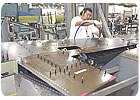
At the Vought Aircraft facility in Dallas, an assembler installs fasteners in the empennage of a V-22 Osprey. Photo courtesy Vought Aircraft Inc.
Getting Certified
For most assemblers, especially Tier 2 or Tier 3 suppliers, getting certified to AS9100 shouldn’t be too intimidating, especially if they’re already certified to ISO 9001. “For a company with less than 300 employees, AS9100 can be put in place, from scratch, in less than 3 months,” says Paris.Assemblers will need to pay registrar fees, and they may want to hire a consultant to help prepare for the certification audits, but capital investment should be minimal.
“One expense that’s sometimes hidden is calibration,” Paris points out. “AS9100 requires measurement equipment to be calibrated regularly, so there’s usually some sticker shock when they find out that their [coordinate measuring machine] needs to be calibrated every year.
“There are ways to minimize those costs-you have to be smart about what you calibrate. But a lot of companies don’t calibrate their equipment regularly or just follow rudimentary practices.”
The first step in becoming certified is to obtain a copy of the standard from the SAE and read it over. “That’s seemingly obvious, but a lot of companies forget to do it,” says Paris.
The next step is to do a gap analysis audit. The goal is to identify areas that fall short of the standard or are completely noncompliant.
“Most companies-especially assemblers-are 70 percent to 80 percent compliant to the AS9100 standard without even realizing it,” says Paris. “There’s no need to start from scratch or reinvent the wheel. You only want to do the things that are missing and leave everything else alone.”
Although the standard details the required elements of a quality management system, it doesn’t explicitly spell out how those elements should be implemented, leaving that up to each manufacturer. If a procedure or process is found to be nonconforming, assemblers need to document what went wrong, why it happened, how it was corrected and how it will be prevented in the future.
“Corrective actions are often poorly written and don’t get at the root cause of the problem,” says Dionne. “A good tool for doing that is ‘five whys.’ Say an auditor found that a gauge wasn’t calibrated. Often, we’ll find the root cause analysis was just a repetition of the finding: ‘The gauge wasn’t calibrated.’ Why wasn’t it calibrated? The technician didn’t calibrate it. Why didn’t he calibrate it? Because the recall system didn’t work. Why didn’t the recall system work? Because the software isn’t working. Oh, so it’s an IT problem!
“The idea is to ask ‘why’ five times, and you typically don’t get to the root cause until you’ve asked it at least three times.”
After assemblers earn AS9100 certification, it’s valid for three years. However, assemblers will still need to be audited annually or biannually to ensure they remain compliant. If a new manufacturing process or product line is added, it can be assessed during these surveillance audits. If assemblers are certified to an earlier version of the standard, they need not be recertified to the latest version until the current certification expires.
Marvin Engineering Co. Inc. (Inglewood, CA) has been certified to AS9100 since 2004. The company assembles missile launchers and ejector racks for military jets and helicopters. Assembling these devices is no mean feat. For example, the TER-9A triple ejector rack for the F-16 is comprised of more than 500 mechanical and electromechanical parts.
Another assembly, the AMRAAM missile rail launcher, is used to fire missiles from various aircraft, including the F-15, F-16, F-18 and F-22. Available in three configurations, each launcher requires extensive acceptance testing and environmental stress screening. Testing is performed on the final assembly, as well as the subassemblies and components. Testing includes high and low temperature cycling, vibration, electrical, functional and pressure testing. To date, the company has delivered more than 4,500 launchers.
Every step in the manufacturing process-from obtaining the raw material through machining and assembly-is checked for quality before and after completion, and the results of each inspection are documented, says Carlon Washington, a quality engineer at Marvin.
Washington says the toughest part of getting certified was streamlining his company’s procedures and writing work instructions. Overall, the process wasn’t too difficult and took about six months to complete. “There were no surprises,” he says. “The standards didn’t require us to do anything that we weren’t already doing.”

